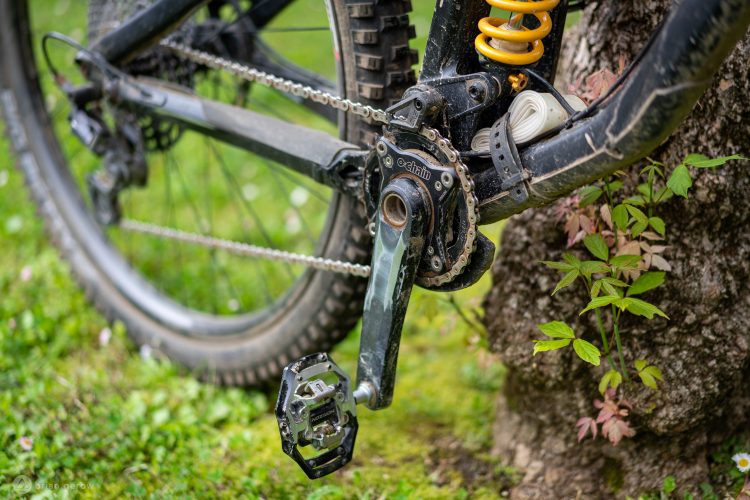
Will mountain bike cassettes ever have enough gears to satisfy riders? Are 1-by drivetrains just a fad, or are they truly for the masses? We’ve been tracking mountain bikers’ preferences for drivetrain configurations over the past 3 years, and the data paints an interesting picture.
Cassette size preferences
Older mountain bikers will remember 7- and 8-speed drivetrains from many years ago, so clearly there has always been an appetite for bigger cassettes with more gears to choose from. The chart above shows Singletracks readers’ preferences for various cassette sizes: blue represents 12-speed, red represents 11-speed, yellow represents 10-speed, and green represents 9-speed. Survey respondents were also able to choose “other” for drivetrains that fell outside the available choices, though in each year these responses represented just 1% of the total.
Starting at the top of the chart, we see a slow decline in 9-speed preferences. Over time it seems 9-speed drivetrains are slowly being replaced, but their owners don’t seem to be in any hurry.
[see_also id=’219270′]
Next, we see a dramatic reduction in the number of riders who say they prefer a 10-speed cassette. Back in 2015, 52% of respondents said they preferred 10-speed cassettes; in 2017, that percentage was cut to less than half that amount, at just 25%.
Judging by the red band, 11-speed cassettes were going strong until last year, when 12-speed cassettes became available. From 2015 to 2016, 11-speed gained 11 percentage points, but since 12-speed was introduced, it’s only added 5 percentage points. It seems many riders truly do want the latest and greatest, or else there is truly a need for just one more gear. The question is, would the same pattern continue if someone were to make a 13-speed cassette?
Finally, it appears 12-speed cassette preferences are growing at a healthy, steady clip, but they’re not exactly ramping up. Note, however, that this survey was administered just before news of SRAM’s affordable 12-speed GX group was leaked, which surely made it more compelling to some who may have expressed a preference for 11-speed cassettes. Next year’s survey will certainly tell the story.
It should be noted that many bike brands are speccing SRAM’s 12-speed GX group on 2018 bikes in the $3-4K range, which will certainly drive future adoption. Do new mountain bikers truly prefer 11- or 12-speed drivetrains, or is it all they know? Unfortunately our survey data doesn’t answer that question.
How many chainrings?
One-by drivetrains aren’t for every rider, and some have accused brands and even fellow riders of simply jumping on the one-by bandwagon over the past few years. But the following chart paints a pretty clear picture that the majority of riders are quickly being sold on the benefits.
Once again, we see that older, 3-chainring drivetrains (yellow band) are slowly being replaced, perhaps as parts wear out. Sure, 3-ring cranks are still available–Shimano even markets a newish 3×11 drivetrain–but for some, hanging onto a 3-by drivetrain might be a matter of economics rather than a true preference for its performance.
[see_also id=’211179′]
From our limited data set (just 3 years worth,) it appears the number of defectors from 2-by (red band) to 1-by (blue band) may have slowed over the past year. As riders have had a chance to test multiple configurations, it seems the market may be settling down.
Finally, just look at how many riders prefer a 1-by drivetrain! In only two years time we’ve moved from less than half to a clear majority preferring just a single chainring. Of course, by adding more gears to improve the range of 1-by drivetrains, companies are making it easier for more consumers to switch, especially when they’re able to get nearly the same range as a more complex 2 or 3 chainring system.
Your turn: What do these charts tell you about where mountain bike drivetrain preferences are heading?























10 Comments
Oct 6, 2017
Oct 10, 2017
I ride 1x10, but, honestly, 1x9 is plenty for me. I don't tend to ride tarmac to the trails and its fairly rare I evnd up on pavement for a significant distance. I just don't need the tall gearing.
On my Hybrid however, I do like a greater range. I currently run 3x9 on it.
Anytime you can free up handlebar space is a nice thing too. One less shifter, one more thing you can put on...dropper, pop-loc, light, bell...
Oct 3, 2017
Oct 2, 2017
Oct 2, 2017
Personally, I think the 1x drivetrains just make sense. I've found the simplicity of mine to be really liberating while riding ..... even in my hilly part of the country, a 1x with a 45 or 50 tooth cog can get you up some pretty big inclines (at a snail's pace mind you, but you can climb them).
Do you have any drivetrain sales data from Shimano and SRAM? I'm guessing it would verify your end-user data; but it would be good to see.
....and what of the internally geared bikes lurking in shadows? Will they pose any kind of challenge in the next 5 years or are they just an "also-ran?"
Oct 2, 2017
...Oh I have, it's an extremely interesting article; hence my question here. Also, I would love to see some sales/market penetration data from the internal drive-train vendors on this; it could be interesting.
Oct 2, 2017
Oct 6, 2017
Oct 2, 2017
Oct 3, 2017
I like it because when I use my hardtail as a gravel/jeep road bike, I have a 'big ring', but when I'm on occasional single track, I have a little ring. So I have large range, without the big gaps on the cassette which really make for some awkward cadences.
But I will admit, I rarely switch between chainrings on a particular terrain.......